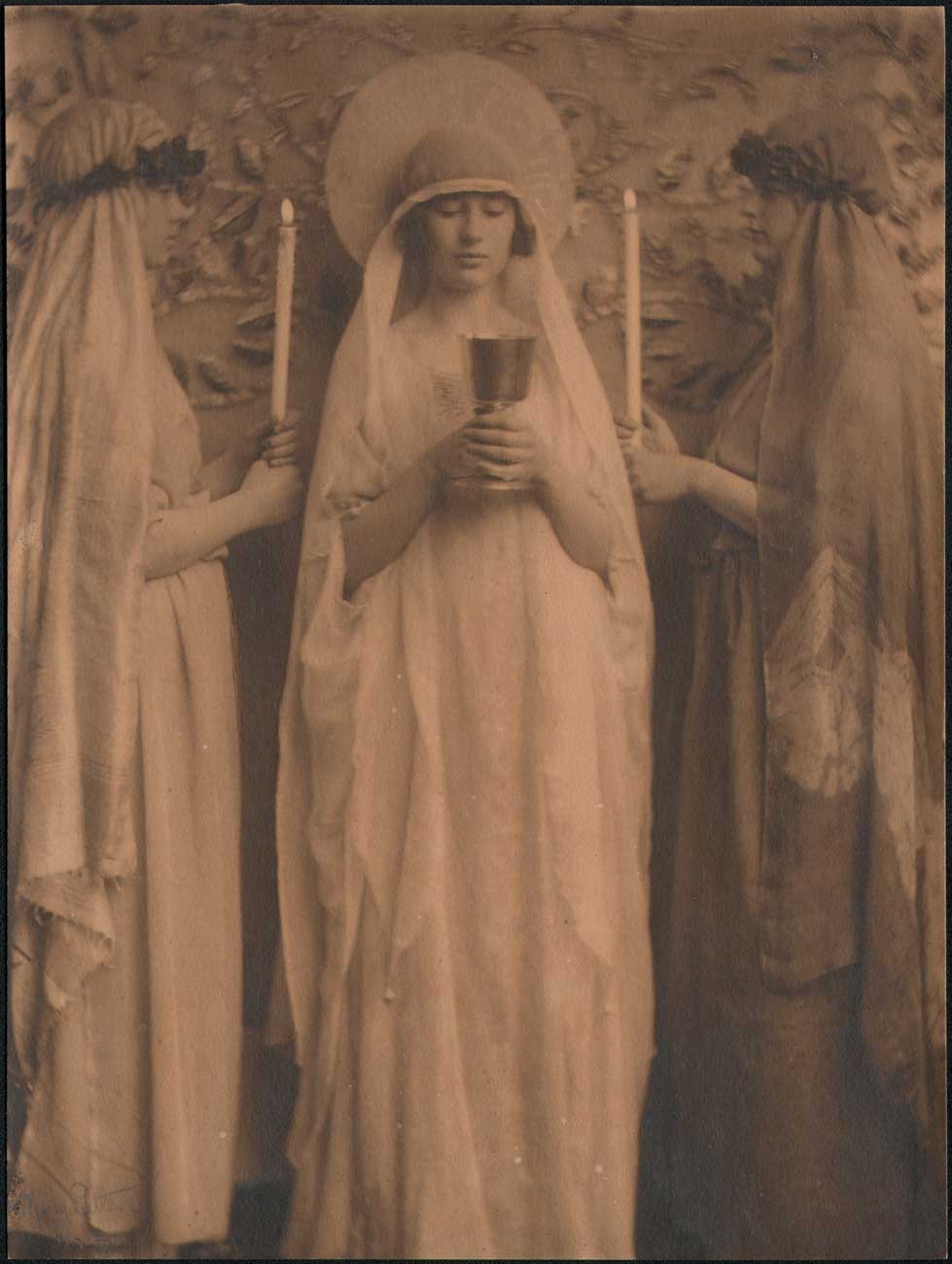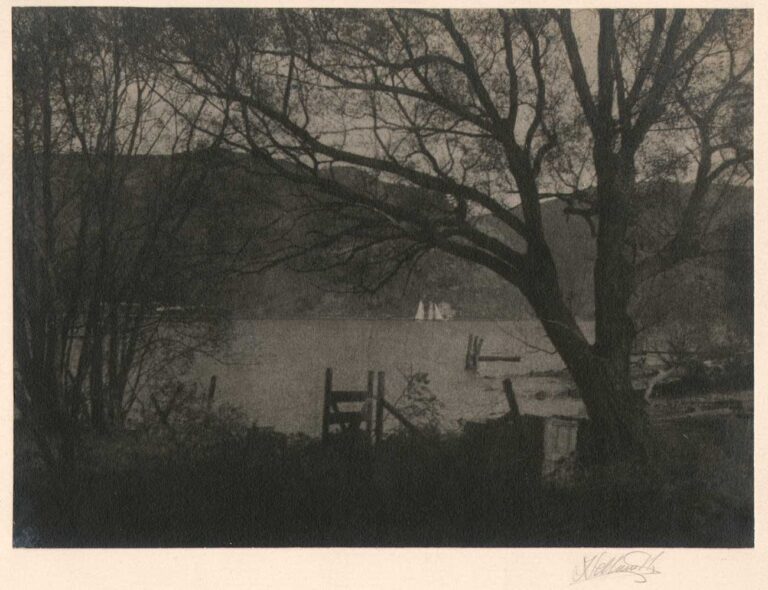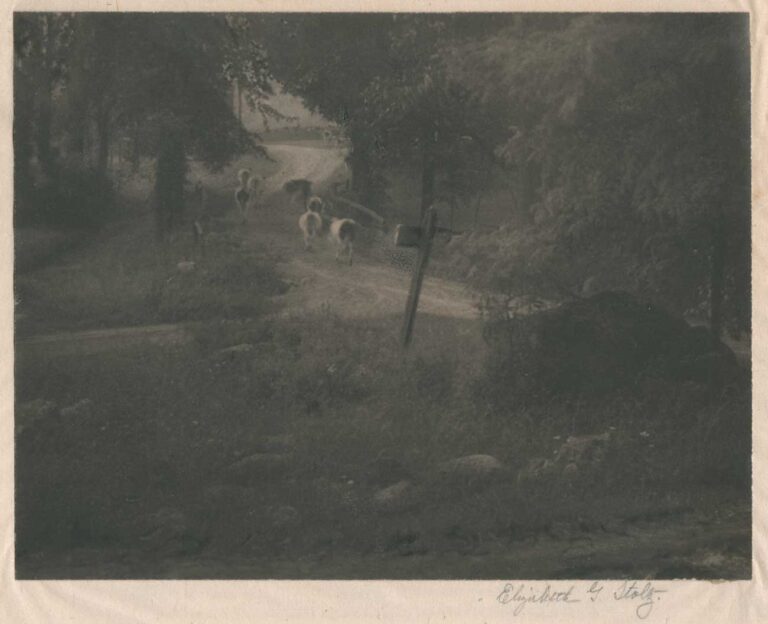
Mary Magdalene and the Holy Grail
Mary L. Patten: 1870-1950
Boston professional portrait photographer Mary (Laura) Patten first graduated from English High School of Boston in 1889, and then attended Massachusetts Normal Art School in Boston, (now known as MassArt) for four years, where she graduated with a diploma. In 1920, after a successful career, she recounted she had “drifted into professional photography very much by chance, finding the knowledge of light and shade and composition, which I gained in the art school, very helpful.” Around 1900, her first studio on Boston’s fashionable Boylston Street was shared with Anne Pilsbury, a like-minded and talented photographer who had been mentored by Philadelphia photographer Mathilde Weil. Patten maintained a series of studios on Boylston into the very early 1920’s based on current research using city directories, with this Biblical allegorical portrait of three subjects reminiscent of Mary Magdalene holding the Holy Grail at center taken in 1923.
Timeline: Mary L. Patton
1900: Occupation listed as artist on the U.S. Federal Census.
1901: Patten is listed as member of Boston Society of Arts & Crafts in their journal. Her studio is located at 248 Boylson St. in Boston, remaining here until at least 1915. She shared the space with fellow photographers Anne Pilsbury, (b. 1875) who had first established it in the Spring of 1899: “in what was once an old dwelling-house, and courageously began business among a host of well-known photographers.” (1.) Patten was in good artistic company: Pilsbury had exhibited at the Philadelphia Salons of 1900 and 1901. At the time, they shared the studio with photographer Alice Austin. ( sometimes confused with Staten Island, N.Y. photographer Alice Austen)
1902: In the April issue of Handicraft, the journal of the Boston Society of Arts & Crafts, several advertisements appear: 1. an exhibition of photographs at the Boston studios of Patten and Anne Pilsbury located at 248 Boylston Street would take place from April 24-26th and 2., mentioning special attention would be given to photographing children at these same studios or in their homes, with studio telephone listed as Back Bay, 308-2.
1907: The International Studio magazine comments on an exhibition of artistic photography that took place from Feb. 5-27 at the Boston Society of Arts & Crafts in Copley Hall, which included among others some fine portraits by Miss Mary Patten and Miss Alice Austin of Boston. Patten’s photographs were:
869. A. Portrait
870. A. Girl Reading
871. A. Miss Dorothy Winsor in fancy dress
872. A. Portrait, Mrs. Walcott Johnson’s Children
1909: exhibits 10 photographs in the Sixth Annual Exhibition of Photographs at the Worcester Art Museum from Oct. 30-Nov. 29. Titles are:
113. Peter.
114. The Story-Book.
115. In Fancy Dress.
116. Boy Whittling.
117. The Newspaper.
118. By the Window.
119. Portrait of a Girl.
120. The First Grandchild.
121. The Mirror.
122. Portrait of a Child.
1915: Along with Clarissa Hovey and Jean Oliver, Patten acts as judge for the Annual Exhibition of the Boston Young Men’s Christian Union Camera Club.
1917: Patten studio now located at 270 Boylston Street as printed in the Boston Register and Business Directory. The studio was located here until at least 1922 and possibly later. In 1918, this directory listed other businesses at this address, including the Gardenside Bookshop, the Home Craft Demonstration shop, the illustrator Stillman Powers (who was also a photographer) and artist Louise M. Smith. By 1921, the directory states artist G. Paterson Love hung his shingle here with no mention of the Demonstration shop. In 1922, directory lists tenants as Patten, Love, and the Book Shop for Boys and Girls.
1920: The following profile by Patten appeared in the 1920 volume Careers for Women:
THE PHOTOGRAPHER MARY L. PATTEN
Description of occupation
Photography has a wide field. It may be used commercially, as in advertising work which includes the copying of portraits, manuscripts, etc.; in scientific work; in portraiture, in which there is a chance for a very wide variety, from a sharply focused picture showing every detail to a study of light and shade made with a soft focus lens. There is a demand for each kind for various purposes and to suit different standards of taste. I am a portrait photographer. Many women are doing the commercial work, combining with it developing and printing for amateurs.
Much portrait work is done now in homes, giving a pleasant change from constant work in the studio. The tendency is toward a natural picture, more of a snap-shot, in contrast to the old-time, carefully posed portrait which was often stiff.
In the old days only a north light was used; now I use sunlight and window lighting, often taking my subjects against the light, which gives a very charming effect. When I began my home portrait work twenty years ago it was practically unknown and was very successful. The established photographers told us we could not make a good negative out of a studio, so to make sure we lugged around the big studio camera, strapping the stand to the back of a cab; now I carry a light outfit in a straw suitcase and use a rapid lens and rapid plates or films.
Preparation necessary
In the matter of training or preparation, nothing can take the place of actual work with a camera and in the dark room, developing one’s own negatives; then printing from the negatives, experimenting with various kinds of paper to get the effect desired. Most professional photographers served their apprenticeship in some studio, working in various departments. A rough knowledge of chemistry is very useful, although I am afraid the average photographer is far from scientific. My own training began in the Normal Art School, where I spent four years, and I drifted into professional photography very much by chance, finding the knowledge of light and shade and composition, which I gained in the art school, very helpful.
The length of training for the portrait side of the work depends entirely upon the ability of the person. Work in a school is of more value after some practical work has been done, and much may be gained by experimenting with a kodak and developing the negatives. From the standpoint of the artistic photographer the best school for portrait work is Clarence H. White’s in New York. There are two others in New York which give more of a commercial training, and one in Effingham, Illinois. These schools are:
Clarence H. White School, 122 East 17th St., New York City.
New York Institute of Photography, 141 W. 36th St. New York.
E. Brunei College of Photography, 1269 Broadway, New York.
Illinois College of Photography, 910 Wabash Avenue, Effingham, Illinois.
After training gained both in studio and school, if possible, the worker seeks the place for which her taste and ability fit her. She may choose developing, retouching, printing, finishing, or making of the negative, or, if she is ambitious and wishes to work out her own ideas, she will start a studio of her own. In that case, since there is much competition and rents are high in a large city, it is wise to start in a small town and not expect more than to cover expenses the first year. The outfit, camera and lenses cost very much. After the first year one should make a good living from the work. I work but nine months of the year, since the summer is not a good season in Boston, and make a good living from it. Many photographers go either to the seashore or mountains for the summer trade.
Qualifications desirable for success
To succeed requires infinite patience with the many difficulties to be overcome in handling plates, films, chemicals, and printing paper. For example, one must figure on the slowness with which things work in cold weather and the speed in summer. Infinite patience and tact are required in handling restless children and stiff and self-conscious grownups. A woman’s individuality should count here. Each year by experimenting, skill and knowledge of the profession are added.
Advantages and disadvantages
The profession has many advantages; chiefly I should put its great variety, especially to the worker who is jack-of-all trades. There is always something new to try out. It is by no means sedentary and leads one much out of doors. Again, one meets many interesting people and makes friends and acquaintances. Its disadvantages have been now rendered very trifling, since work in the dark room is shortened by new methods and the hours of confinement are not long. Possibly one third of the people engaged in photography are women and the pay is now very good in comparison with clerical work. There seems to be a steady demand for workers.
Reading
Many of the photographic magazines offer helpful suggestions. The “Photo-Miniature,” “a monthly magazine of photographic information,” is especially good. Copies may be bought at photographic supply stores. There are innumerable handbooks on every branch of the subject, but, as a rule, they would be too technical for a beginner whose best book is a small camera. (2.)
1921: Patten listed as one of 26 members of the Photographers’ Guild affiliated with the Boston Society of Arts and Crafts. Some of her work was including in a joint exhibition of Guild members at the Society’s galleries from Oct. 18-29.
Mary Magdalene and the Holy Grail, the title assigned to this work by this archive, is based on subject matter alone, and may not reflect a true representation of the artist’s intent or original purpose.
print details recto: toned print signed in graphite in corner recto: Mary Patten 1923
verso: adhesive on upper margin: with support gone missing
Notes:
1. Anne Pilsbury: in: Representative Women of New England : Julia Ward Howe, Mary Hannah Graves: New England Historical Publishing Company: 1904: p. 286
2. THE PHOTOGRAPHER: Mary L. Patten: in: Careers for Women: Catherine Filene: Boston & New York: Houghton Mifflin Company-The Riverside Press Cambridge: 1920: pp. 72-75



